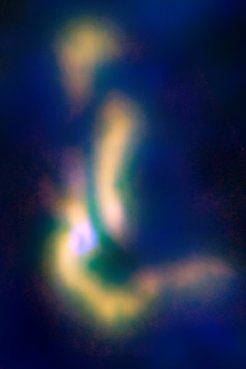Birth of a star quartet
An international team of researchers has discovered something extraordinary in space: a new star system forming from parts of a filamentary gas cloud.

Unstable quadruple breaks apart
The experts calculated that the two stars which are the shortest distance apart form a stable double system, while the other two stars which are further apart will be catapulted into space after about half a million years. “Star systems with more than three members are unstable and prone to interference,” says Jaime Pineda, now at the Max Planck Institute for Extraterrestrial Physics, who is the first author of a study that has just been published in Nature. The most probable scenario is that the quadruple will disintegrate and only last for a “short” time.
Not only did the researchers succeed in observing the formation of a multiple star system from a fragmented gas cloud for the first time; it is also unusual how quickly the system is forming. By astronomical standards, the estimated 40,000 years are “exceptionally fast”, as Pineda stresses. Nor had anyone been able to observe that stellar systems develop from parts of a filamentary gas cloud until now: “At first, we thought that the fragments wouldn’t interact with each other.” Often, only a triple system would form.

Unique system studied
Pineda is member of a research collaboration that observed the star system and simulated its genesis and demise. At the time of the discovery, he was working as a postdoctoral researcher in Professor Michael Meyer’s group at the ETH Zurich Institute of Astronomy, as was co-author Richard Parker, who determined the stability of the star system on the computer. Astrophysicists from several US and European universities, including Harvard, Yale and Liverpool John Moores universities, were also involved in the project. The researchers made their observations at the Very Large Array in the US, which they used to detect emissions originating from ammonia molecules (NH3) in the gas cloud.
“Multiple star systems are very common in our galaxy,” says Michael Meyer, professor at the Institute for Astronomy at ETH Zurich. Most researchers, however, have concentrated on the birth and development of individual stars as this is more straightforward. On the other hand, scientists who analyse multiple systems usually tend to focus more on the end result of the star formation. For this reason, this discovery is something very special.













